What is needle applicator, abbreviated iplikator?
It is a system of metal and plastic modules with sharp spikes fixed to the polyethylene or textile mat, designed especially to eliminate acute and chronic pain.
Where and how iplikator originated?
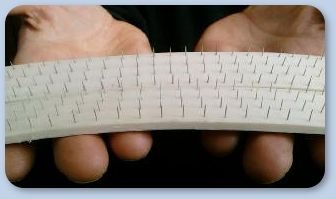
Iplikator Kuznecova
First iplikator was invented in Chelyabinsk in Russia by Ivan Ivanovich Kuznetsov. I. Kuznetsov suffered for a long time from chronic kidney disease, but classic treatment did not help him. After long lasting and ineffective treatment, doctors practically admitted that they could not improve his health condition. But I. Kuznetsov did not give up. After a slight improvement of health condition ( which occurred after treatment by specialists in acupuncture), he studied all available literature on Chinese and Tibetan medicine , whereupon he constructed his first iplikator – device acting by lots of sharp spikes on the body, which after several applications brought him a noticeable improvement in health conditions. Doctors who previously considered treatment of Kuznetsov non-perspective, studied with interest RTG pictures from the time before and after use of iplikator. They found that Kuznetsov completely healed. Kuznetsov showed to surprised doctors, who previously considered him hopelessly ill, his invention: the strip of white rubber with stuck sewing needles.
Doctors advised him to present his invention in Moscow at the Ministry of Health, but they only mocked his provincial invention. But it did not stop him. Over the next ten years I. Kuznetsov treated people, condemned by official medicine, and carefully describes each case in his diaries. He thus gathered extensive information and came back to Moscow. I. Kuznetsov asked distrustful members of the commission at the Ministry of Health, who assessed the invention, for the opportunity to help hopelessly ill person. The patient was a civil servant, who after full recovery helped his rescuer to promote iplikator. I. Kuznetsov thus became a known healer. In 1980, I. Kuznetsov together with a team of VNIIFK scientists, (Scientific – Research Institute of Physical Culture in Moscow) received a patent certificate of authorship no. 791378 for „device – iplikator to increase human performance“. Researchers I. Kuznetsov and Z. L. Nagiev proposed methodology for its use. This method will be called by doctors in future as „needle – massage“ or needle-application, which means exposure of certain part of the body to large amount of sharp spikes. Needle application method has become a new kind of therapeutic and prophylactic restorative massage, which can be used to treat acute pain and at extended use to obtain a permanent healing effect. Since metal needles of iplikator could not be used at home, they constructed in the scientific – research institute of physical culture in Moscow a iplikator from non-toxic plastic as analog to metal needles – module with a relatively sharp needles, but which excluded a possible perforation of the skin. Photo iplikator-detail.jpg not found!Iplikators with metal needles 8 mm apart Photo nakres.png not found!from each other were replaced by plastic spikes (with height of 5 mm, spike base diameter 1 mm) certificate of authorship no. 986422, 1667863, 30118, patent 30118 – patent owner A. N. Nekrasov.
Since 1987, many medical facilities tested a new kind of Iplikator and it was subsequently approved by the Ministry of Health of the USSR. Iplikator thus became available to a wide range of consumers. Approximately 100 enterprises in the USSR began producing Iplikator; about 70 million pieces were produced. Thus, almost every family in the former USSR had iplikator in their home medicine cabinet.
I. Kuznetsov was not a doctor, therefore he lacked basic clinical knowledge, but thanks to the natural feeling he initiated a new direction of physiotherapy, subsequently supported by many doctors.
New stage
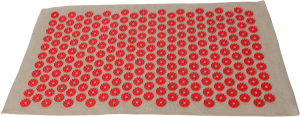
Iplikator D1
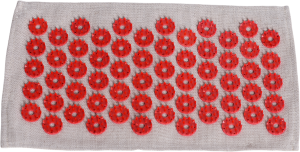
Iplikator A1
The second wave of iplikator development began outside the former USSR, in Czechoslovakia. Company IPLIKATOR s.r.o., founded in 1990 by graduate from Moscow State University (MGU) Prom. Phil. Valentino Dikarev, began production of iplikator for the first time beyond the borders of the former USSR. All rights to use a new type of plastic module outside the former USSR received Prom. Phil. Valentin Dikarev, company IPLIKATOR s.r.o., Slovakia. Based on consultation about production of iplikator with I. I. Kuznetsov and also VNIIFK team of researchers led by Dr. A. N. Nekrasov, company IPLIKATOR, s.r.o. started production of iplikators and after a short time has become one of the most famous companies in the former Czechoslovakia. Virtually every family had classic iplikators D1 and A1. Not only the fact that iplikator, based on research of doctors – specialists has been recognized by the Ministry of Health and the Department of supervision of medicinal products as medical device, helped this, but mainly a really fast and effective possibility to get rid of pain, especially in the lumbar and knee joints at home. The company received about 1 500 letters a day with orders for iplikator and also a large number of grateful letters.
After the split of Czechoslovakia in 1993, the company IPLIKATOR s.r.o. based in Košice, Slovakia, introduced new types of iplikator, which greatly improved the original attributes of original iplikators and their use. The author of industrial and utility patterns registered in Czechoslovakia and Germany was Prom. Phil. Valentin Dikarev , making iplikator got epithet „Iplikator of V. Dikarev“ . The numbers of registrations of Czechoslovak industrial and utility patterns: V – 26171/92, V-24376/91, V – 26741–93, V – 26845–93, V-24760/91, V – 01321–93, 01102–93, 01103 – 93 and also German pattern М9200893.3.

Patents
New types of iplikator were later registered in the EU in community service organization of the Internal Market OHIM in Alicante under Art.19 from 6/2002 on patent industrial patterns.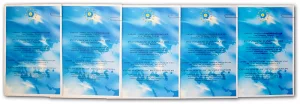
Basic characteristics of new iplikators from collection of Valentin Dikarev
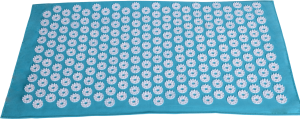
Iplikator D3
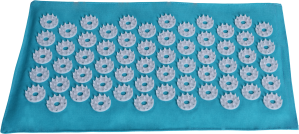
Iplikator A2
The new iplikator include iplikators type D3 and E1 with a soft foam insert, which significantly offset the unevenness of the body .
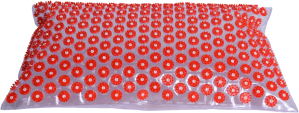
Iplikator D4

Iplikator E1
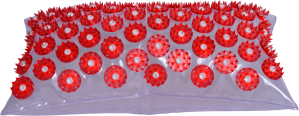
Iplikator E2

Iplikator D5
Inflatable textile iplikators D5, D7, E1 and E3 and inflatable iplikators on PVC film D4, E2 and D8, which are better adapted to the surface of the spine and neck with minimal inflation. Since inflatable iplikator put higher pressure on the skin, they are harder, but the pressure on the body breaks down evenly. Large inflatable iplikators inflate approximately to one tenth of its full capacity. Small iplikators to two thirds of its volume.
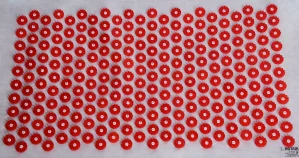
Iplikator D6

Iplikator A3
Iplikators made of foil A3, D4, D6, D8, E2, E4 better meet the conditions of hygiene. They can be disinfected by high heat steam or disinfectant liquid.
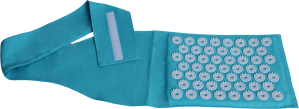
Iplikator B4

Iplikator B5
Special soft joint knee iplikators in cotton fabric cover in two versions.
After bandaging leg with iplikator and after walking with it for about half n hour, patients experience significant relief from pain and often complete removal of all pain in the affected joint.

Iplikator B8
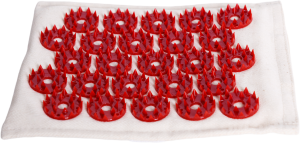
Iplikator B6
For sore elbow joint is used iplikator B8 and B6 for local contact pressure.

Iplikator C1
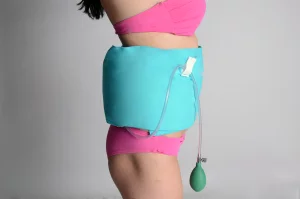
Iplikator C1
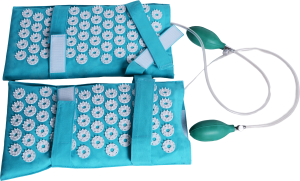
Iplikator E5
Photo zone-riflessive.jpg not found!
Pneumoiplikator C1 with possibility to attach iplikator at back pain to vertebrae spine. When using this iplikator it is not necessary to lie on iplikator, this kind allows moving also at the vertebrae spine pain. When using iplikator C1 mild vertebrae pain usually recede after half an hour of application. Pressure on the skin during application must be at the threshold of pain.
Iplikator for feet reflex zones E5 helps to regulate the pressure on the feet reflex zones, improves legs blood circulation, especially at diabetes.
Photo D8.png not found!
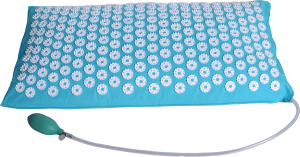
Iplikator D7
Textile and foil pneumoiplikators under the spine and neck D7, D8, E3 and E4. These iplikators allow to regulate the volume of inflated air and thus also the pressure on the body. The patient may regulate itself an optimum air volume of iplikator in lying position by the use of pump.
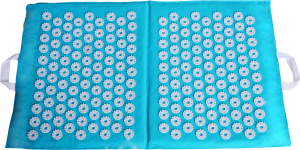
Iplikator D2
Folding iplikator D2 is suitable for better storage. Facial iplikator A6 is used to remove facial pain and at massage for cosmetic purposes. Density of spikes of facial iplikator is significantly higher because of the sensitivity of facial skin.
Some of the necessary information on history of iplikators expansion in other countries
Before the accession of Slovakia to the EU, the main dealer of the company Iplikator, s.r.o., was in Europe a German company AKUMAT that realized distribution of iplikators called " AKUMAT". After accession of SR to the EU iplikator became selling in many EU countries , but mostly in Sweden through the Institute of Massage in Malmö. It was in Sweden where were in 2008 for the first time discovered counterfeits of soft Iplikator D3. History is as follows – after repeated rejection of direct sales of Iplikator to one of sub dealer, except for the main dealer, sub dealer (Mrs. Nadine Reutersward) sent her son to India for the purpose of organizing a production of counterfeit iplikator D3. Some changes in the dimensions of this iplikator, number of modules and spikes sharpness have been made. Also new name for this product was invented – " Shaktimat " , also new history of its origin was made up ( son traveled in Tibet and saw monks lying on fakir carpets, and at that moment Shaktimat idea allegedly came to his mind). Sponsors were engaged to advertising and marketing and advertising campaign shamelessly began after introduction of iplikator D3 under a new name „Shaktimat – Swedish carpet“ , it is a note on enhanced opinion of the Swedish preference for honesty . Such a massive advertising could not remain unnoticed by the Chinese . In the near future , numerous Chinese fakes of iplikator D3 appeared under various exotic names like Yantramat , Spick mat , qmad acupressure etc. All share a single common characteristic – neither one of them did not pass the necessary approbation by doctors – specialists and registration of institutions of drugs control . In order to circumvent the patent coverage , most manufacturers of fake altered the sharpness and amount of spikes, number of modules and thus making their products ineffective in eliminating pain and other diseases, even though they virtually state incorrectly indicate healing effects of their products in advertisements and instructions. It should be noted that the distribution of spikes and modules of iplikator, as well as their quantities were selected as optimal after the amount of research and experiments by various medical organizations, and they can not be placed arbitrarily, as it is in case of fakes.
How the iplikator effects ?
Great discoveries are quite simple. Everybody understands great discoveries. There is no need of hundreds of pages to describe the great discoveries. Let’s remember the doctoral dissertation of Michael Faraday on law of electrolysis, which was written only on two pages. Also iplikator may be called such great discovery. Also I. Kuznetsov solved the problem with one shot. He removed acupuncture points, meridians, he removed all the theory by one simple method – iplikator effects by hundreds of needles in large areas of the body. This is the essence of the invention. This mechanism of effecting may also be called as the mechanism of micro-needle-flexotherapy. Since the iplikator is a great stimulator, it enhances microcirculation, induces the release of muscle structures, activates the lymphatic and blood circulation, improves nourishing of all parts of the body, to which it is attached. There occurs a biological feedback with the vital organs, centers and all sections of the nervous system. Hormonal system of the body also reacts by restoration of homeostasis. The production of own healing substances in the body, neuropeptides, endorphins , enkephalins etc. take place. It is known that in our body there are a number of points that are responsible for the functioning of various internal organs including the spine. Under the effect of iplikator to the entire surface of the spine are stimulated the exchange processes in cartilage tissue of intervertebral discs, the inflammation of nerve endings is reduced, blood circulation in the internal organs and the brain improves. In place of immediate effect, spikes of the module irritate the skin, thus expanding capillaries and create a pleasant feeling of warmth. In other words, no matter in which way is the iplikator used, the result is similar to the effect of the traditional Chinese acupuncture, but without piercing the skin. Thanks to combining local and overall effect of iplikator, it usually improves also the overall health of the patient. By effect of the iplikator to the spine, sleep normalizes, pain weakens or disappears, work of internal organs improves, employability increase, the mobility of different muscle groups improves, sensitivity, for example after stroke, improves. Iplikator under pressure also stimulates the sympathetic and parasympathetic nervous system. The pain usually disappears already under the influence of effect of any viable pressure for a few seconds or minutes. Thus acting through the nervous system to the muscular system, the patient feels during 10 seconds how the muscle under iplikator relaxes. According to the method of its effect, iplikator can be compared with hypnosis, but hypnosis effect goes from the brain to the body, while the effect of iplikator goes from the body to the brain. Healing by iplikator may be included into the types of physioprocedures determined for home use. Massages procedure by iplikator can be performed anywhere, at work, at home, on the road. You can lie on iplikator, you can place it on the armrest of the chair, lean on it, and so on. Patients typically experience as fatigue wears off and powers renew quickly.
What are the most common places for iplikator application?
Iplikator is usually attached along the spinal column in the lying position or directly to the painful parts of the spine, and locally wherever the patient feels pain. After the first application of iplikator, patient feels lightness of movements and often enhanced thinking ability. The arising initial pain reaction to the spikes effect (no more than 3 minutes) changes to the feeling of pleasant warmth and sleepiness.
Using reserves given to human by nature, people using iplikator achieve better use of the possibilities of the body, thus ensuring a full health. And most important, they can realize that at home. Long-term use of iplikator starts the process of internal regeneration of human organs – sometimes it allows treating also serious diseases.
For what health problems is the use of iplikator recommended?
Iplikator is designed and is successfully used for:
- Prevention, reduction or complete elimination of pain at radiculitis and osteochondrosis,
- removal of troubles with the peripheral nervous system, at cervical-shoulder syndrome, also in neurological manifestations of spine osteochondrosis,
- Increase body resistance during rapid muscle fatigue,
- Elimination of pain syndrome of muscular tissues of the spine, neck, arms and legs muscles,
- Elimination of muscle spasms, pain in the joints, restoration of mobility in joints and spine,
- Elimination of chronic insomnia, sleep normalization, removal of stress states and headache,
- Reduction of fat accumulation as a result of strengthening the blood circulation in the superficial tissues of the waist and hips area,
- Restoration and enhance of the activity at work, sport and in everyday life.
How to use Kuznetsov iplikator?
SMALL IPLIKATOR – 35 × 19 cm
Iplikator must be attached to the painful area (on the naked body), then push with your hands until the pain threshold, which you can stand during 40–60 seconds so, that every 10 seconds intensify the pressure while the patient is moving muscles in the painful area. Procedure of application of iplikator to the painful area is repeated until complete elimination of pain. Iplikator can be worn for a long time on the painful area and it should push and fastened by an elastic bandage, belt, towel and so on. When used on the joints, iplikator must be attached to the outer side of the joint so, that the spikes of the iplikator do not push on the nervous and vascular system (which is located in the poples, armpits, groins, on the inner side of the elbow), uniformly fasten with elastic bandage by slight pressure to the body for 30–45 minutes. For joints there are specially manufactured a joint knee iplikator B4, B5. When using the knee joint, try to walk slowly or repeatedly bend and straighten the leg while sitting. Simultaneous application of iplikator to the joint and large iplikator to the spine (it is suitable to remain lying on it for 30 minutes) helps not only to eliminate the pain in joints, but also helps to improve the overall condition.
LARGE IPLIKATOR – 38 × 68 cm
In case of back pain and insomnia, it is recommended to use a large iplikator. In case of large iplikator it is necessary to lie on soft base – bed, mattress, until you get used to it, it is possible to repose to iplikator on backrest even for 1–2 hours, depending on the status and consideration of the patient. In case of chronic osteochondrosis and insomnia, we recommend using iplikator 15–20 days regularly before sleep. Then there should be 2 weeks break in order not to reduce the effect of action. While lying on a large iplikator, you will feel exposure of sharp spikes just the first three minutes, but then you will feel the flow of heat and pleasant relaxation that will last throughout the time lying on iplikator. The skin will be red , which is normal when applying iplikator. In case of chronic osteochondrosis, the pain does not go away immediately, but after 10–15 procedures. To ensure maximum contact of iplikator with the surface of body, it is good to use soft or inflatable iplikator. Iplikator can also be used while in motion, that allows the iplikator C1 and knee joint iplikators B4 and B5. It should be noted that the use of iplikator is very versatile. It can be used by the pressure of own weight, auto gravity, as well as by simply pressing the iplikator to the body by hands or by pneumoiplikator. Depending on the type of disease, treatment time of iplikator requires 5 to 30 minutes. To improve the performance of the body and to remove fatigue, 7–10 minutes is usually sufficient. To weaken the stress of the organism, for overall relaxation, the total time of massage is increased to 20 to 30 minutes. Indicator of the iplikator efficacy is feeling the heat in the body, which occurs after about ten minutes of massage. Iplikator treatment should be carried out in several recurring two-week cycles (1–4 treatments per day). Between courses is recommended to take a break for two weeks to prevent habituation. Very effective is to use iplikator simultaneously with conventional therapies.
When to use iplikator during the day?
When to use iplikator during the day depends on the goal you are trying to achieve. If you need to get rid of pain, it is good to use iplikator anytime. If you need to kick-start the body, it is better to use iplikator in the first half of the day. In case of insomnia, use iplikator just before sleep. It should be noted that massage by iplikator affects different people individually. Someone feels lively and full of energy after application, someone comforted, even sleepy. Therefore, duration of iplikator use depends on the individual reaction to the procedure.
Is it possible to massage the face with iplikator?
By gentle application of iplikator A6 with dense spikes on the face, it is possible to improve blood circulation and skin turgor. Similar massage treatments help to maintain young facial contours, improve facial skin flexibility and thereby reduce the number of wrinkles.
What are the advantages of iplikator?
Quick effect, ease of use without expert on acupuncture. Iplikator is designed for both professionals as well as for ordinary consumers. Is designed for individual use, but iplikator on the foil can be easily sterilized and can be used by several patients.
It is not recommended to use iplikator:
- at malignant and benign tumors,
- at skin diseases, large birthmark, thrombophlebitis – at all in place of application. In case of larger birthmarks, warts, and the like, it is possible to remove ring (rings) at this point, from the rug or seal relevant area of skin with plaster.
Iplikator disinfection is realized by using hot water (60 ° C) and brush with the addition of disinfectants (Australian tea tree, medical disinfectant soap). Disinfection can be done also using steam cleaners.
Iplikator is approved by CE certificate.
Plastic contact points are made of non-toxic material.
Used textiles are 100% cotton and flax.
For hygiene reasons, we recommend to use iplikator by one person only.
Clinical tests
Clinical tests were conducted in the Central Scientific – Research Institute of reflexology of Ministry of Health of the USSR , in Institute of Surgery A. V. Vishnevskaya , by specialized clinical hospital No. 8 Z.P. Solovyov in department clinics neuroses, in Central Institute of Traumatology and Orthopedics N. N. Priorov , in Institute of Neurosurgery N. N. Burdenko. Based on these research were developed methodologies of use of iplikator. Methodology of action by needle modules on large areas of the skin surface of the human body were suggested by I. I. Kuznetsov and V. A. Nagiev already in 1979, but the proposed methodology was primarily designed to eliminate fatigue and to enhance human activity, but it did not allow selective effect on internal organs, musculoskeletal system, to eliminate pain syndrome. It is known that none disease is local, and it always causes reflex changes in the segment- related functional units, which are mainly innervated by the same segments of spinal cord and may occur in the skin, muscles, connective and other tissues, and then act on the initial deposit and maintain pathological process in it. By removing these changes in tissues, primary pathological process can be liquidated and restoration of the normal condition of the body. Experts developed and tested a new method for treating internal organs and motor organs of human and called it needle application segmental reflex massage. Its essence is the mechanical action of the quantity of needle modules (application of needles) to spine joints and corresponding areas on the skin surface. These areas are treated with a special device – a needle applicator, which consists of a number of metal needles or plastic spikes which are fixed on the elastic basis in the number of 1 to 16 per 1 cm². Size of needle applicator must correspond to the size of the zone of action. The effect of needle applicator on the skin surface is ensured by slow application and fixation with subsequent massaging movements, while the spikes are not moved on the skin surface. Force of application of needle applicator must be within pain capacity of the patient. Regularly every 30–60 seconds is iplikator removed and applied again. This avoids adaptation for irritation.
Operation is carried out in cycles. It should be noted that due to the uniform pressure distribution of needles on the skin surface, there is no perforation of the skin. To avoid transfer of infection, needle applicators must be used individually .
From the year 1982 until today are realized medical clinical tests of this method in the central medical research institutes and clinics in Moscow. Here are some excerpts from the conclusions.
From the clinical tests protocol of needle applicator, which were realized in the Institute of Surgery of A. V. Vishnevskaya Academy of Medical Sciences of the USSR: "At the majority of patients with osteochondrosis with the secondary painful and root syndrome occurred after completion of the course of needle application a significant decrease of syndrome effects.
At patients with diseases of the upper and lower respiratory tract, due to needle applications improved a drainage bronchial tree, auscultation image improved, dyspnea reduced, lips cyanosis disappeared, at patients with bronchial asthma the number and intensity of attacks of breathlessness reduced, and in many cases, patients could significantly reduce the dose of used drugs or completely abandon their use. From the conclusions of the Central Research Institute of Traumatology and Orthopedics N. N. Priorov MZ USSR: „… at use of needle applicators occurred in a large proportion of patients to reduction or elimination of pain syndrome, muscle tension after pathological bone fractures reduced, higher amplitude of motion in the joints were achieved“, „… positive subjective and objective data have been achieved, allowing to recommend this method in combination with therapeutic gymnastics in osteochondrosis of different parts of the spine, deforming arthritis of large joints of the limbs with reduced mobility and pain, micro trauma of tendons and muscles, states after removal of meniscus of knee joints, post-arthrotomy states and artrolysis of joints with removal of contractures “.
From conclusions of 2nd scientific-research medical institute of N. I. Pirogov MZ USSR: "At use of this method in clinical practice has been achieved at patients with cardiovascular disease, a steady therapeutic effect and improved the functional status of the body, which was accompanied by an improvement of infarction supply (reduction of the negative phase of curve T, approaching the S segment to the isolines) and restoring extra systole of cardiac ventricular. Also indicators of the biochemical analysis of blood improved.
Desired effect of needle application procedure was observed when using at the preoperative and postoperative period.
Specialized clinical hospital no. 8 Solovyov – Department of neuroses, recommends to use the needle method application in the treatment of patients with hypertensive syndrome within essential hypertension with concomitant disorders similar to neurosis, with disorders of the gastrointestinal tract, with the respiratory diseases (chronic bronchitis, pneumonia), with sexual disorders.
Using needle application segmental reflex massage in combination with radioisotope diagnosis of internal organs allowed drawing conclusions (on examples of kidney, liver, respiratory organs):
- after a course of treatments of needle application segmental reflex massage, vascular, secretory and excretion segments approach to the norm,
- blood circulation in the organs improved 2.5–3 fold.
The effect achieved by segmental reflex needle application massage can be used as a new element of screening or diagnostic test, since it causes changes in time parameters of secretory-excretory functions of monitored organ, changes in blood circulation in the organ, it strengthens the existing and thus helps in detection of hidden pathology, it helps to assess reserve ability of functions, which the organ lost, it allows the exclusion of realization of auxiliary examinations. When using the proposed method in combination with chemotherapy, it significantly increases the effect of drugs effective for this organ, thus substantially reduces the dose and shortens the treatment times.
Needle applicator applied to the spinal cord segments and kidney zones supports faster draining of sand and stones from the urinary tract and helps to normalize organ functions.
Needle application segmental reflex massage can be successfully used to accelerate the outlet of the anesthetic state, to treat bedsores, to treat stagnant phenomena in the bronchi and lungs.
Experts elaborated and tested methods for use of needle application massage in practice of sports trainings, at which is the main objective to rapidly increase power capability of athlete, athletes regeneration after major mental and physical load, for the prevention and treatment of sports injuries. Cosmonauts, armed forces, people at workplaces and so, can also use these methods. For the period from 1988 to 1990, experts conducted medical courses with more than 2,000 patients with diseases of the cardiovascular, respiratory, musculoskeletal system, nervous system and gastrointestinal tract at adults and children. While no patients worsened, a positive result was observed in 80% of patients. Proposed method of needle application segmental reflex massage has significant advantages over conventional method of treatment by physical, reflex and manual therapy, massages, and so on, because it is easier and available to all, which makes it indispensable for the prevention and treatment of many diseases and can be widely used in home conditions. Experts developed and tested devices that allow using needle applicator in combination with negative pressure, electrical stimulation and vibration. This will greatly extend the capabilities of this method and generate new prospects for its development.
Clinical tests of iplikators has been realized also by Slovak doctors MUDr. Gustáv Solár of acupuncture center in Bratislava, MUDr. Ondrej Bangha of department of acupuncture in Podunajské Biskupice, MUDr. Juraj Čelko, chief expert of the SR Ministry of Health for physiotherapy, balneology and rehabilitation. Here are excerpts from medical reviews :
„Iplikator was used in a total of 40 patients who did not form a homogeneous set, in most cases repeatedly. Patients tolerated the application quite well; pressure on the skin had to be however modified individually, which is clinically advantageous. We have observed skin reaction in all cases in terms of hyperemia and more or less significant local myorelaxing effect. In no case there were worsening of the patient condition, or the manifestation of intolerance to iplikator. Patients always reported significantly subjective feelings. Immediately after application, we have always observed various degrees of improvement in the condition, rarely, even one application was sufficient. But we applied iplikator mostly repeatedly in intervals of 24 hours also during several days. In evaluation of the results there are not, due to the short time, the results of long-term monitoring, despite that, single or repeated application of iplikator proved to be effective. In this terms, I unequivocally recommended its expansion and introduction into routine practice, where it can also be used in prevention. Based on our recent results, it is assumed that this iplikator finds wide application in our country.“
"In our department, we tested the improved types of iplikator (soft types and inflatable versions, as well as iplikator for local application). For these tests we have all these types of iplikators. Clinical tests confirmed a better grip and adaptability of soft, but especially of inflatable iplikators to the body, and hence their higher efficiency. It also proved the iplikators, which are attached to the body (with fastening belts). We also note that also our suggestions were respected for improvement of the original iplikator, I recommend using the new versions in the clinical practice at maintaining all indicating circuits and contraindications as at the original version of iplikator. In this meaning, I send this statement to the Ministry of Health for note. " MUDr . Gustáv Solár
MUDr. Ondrej Bangha, Department of Acupuncture ÚTARCH P.Biskupice, Bratislava 11. 7. 1990
Subject: Report on testing the „Equipment for acupressure“ (so called Iplikator).
- Purpose of equipment: about the same as other techniques of local physical skin irritation with emphasis on the presence of biologically active zones and points known from traditional Chinese acupuncture.
- Design of tool: spikes made of plastic grouped together on a mat of various sizes.
- Method of application: application under various pressures on the affected part of the body during various time – see instructions.
- Effect: hyperemia of intervention zones followed by hypalgesia and possibly by modification of disturbed body functions. It can be compared with the effect of application " mei hua chuan „ – i.e., so-called. "Beijing hammer“.
- Indication results from the stated – consistent with hammer „mei hua chuan“.
Benefits:
- Simplicity of the used technique
- possible absence of specialist in acupuncture
- any frequency of treatment according to the patient's condition and consideration
- Immediate effect
- Conclusion: it is suitable accompaniment of range of physical therapy; I recommend the production and sales to professional and laic public.
Specialist in neurology, physiotherapy and medical rehabilitation of OUNZ Prievidza MUDr. Vladimír Gažík-
"We can classify Iplicator among appropriate and now quite popular alternative types of medicines. As it is in case of Chinese methods of acupuncture and acupressure, it uses certain natural means, which affect the peripheral, skin system. It differs in that there is no need to know the exact distribution of the specific points on the body. Iplicator irritates the skin receptors on the large area, which transfer it to higher nerve centers. As a neurologist, I dealt with for a long time with the currently most reasonable theory of pathophysiology of pain of Englishman Melzack. According to him, the information from the periphery, and it also affects pain, distribute at certain stages of the nervous system. Not all of them go to the cerebral cortex, where awareness process occurs. The body takes certain measures at lower levels. If the pain is not limited, it forms an entire chain of reactions, biochemical changes that human feels as unfavorable circumstances in the body. By skin irritation at the place of local pain we drown, simply put, the information about pain and we help the body to mobilize its own forces and that it could help itself. It is a non-specific method, which may, however, often greatly help in targeted therapy. It has to be however stated that Iplicator is not appropriate for use in case of acute pain, inflammation, skin diseases and tumors that have be treated in a different way …”
Research on the effect of iplikator called AKUMAT was also realized in Germany in hospital Linderbruna on the Department of Neurology and Clinical Physiology under the direction of prof. MUDr. Bernd Hofferberth.
Experience with clinical application of unspecified mechanical skin irritation on the example of mat with needles Akumat.
Introduction:
Treatment by skin irritation is an old form of therapy that is used in different ways at different difficulties. As examples we mention a dry brush massage to increase blood circulation in the skin, as well as low frequency therapy by stimulation current, or massage hitting deeper layers to relieve pain or increase blood circulation.
In case of mat with needles Akumat it is one of various sizes of plastic mats on which are arranged in circles a plastic, 4 mm high needles. For better adaptation to the needle mat to the surface of body there is a possibility that the individual mats are completely or partially inflated by air. Treated part of the body can thus optimally lie on the mat. It is important that passive position follows directly on bare skin. Treatment is carried out over a time period from 5 to 30 minutes. It should be realized in acute cases three times a day, in case of chronic difficulties, once daily.
By stimulation of the skin by needles irritation, occurs increased blood circulation, which is clinically observed by superheating and erubescence of skin. Superheating leads to pain relief.
The aim of the examination was to examine within the clinical application efficacy and tolerability of treatment by needle mat Akumat at different types of diseases. Needle mat Akumat was also used in case of muscle tension and pain in areas of shoulders, neck and lumbar spine, as well as in case of non-specific stimulation at sensibility disorders within neurological diseases (such as stroke). At treatment with mat it was of course only adjuvant therapy along with here realized regular treatment gymnastics and balneophysical therapy.
Totally 22 patients (9 men, 13 women) were treated. Age of treated patients was between 21 and 87 years (average 45 years). Treatment was carried out in a time between 3 and to maximum of 27 days (average 10.3 days). Daily duration of treatment was between 5 and 60 minutes (average 22 minutes a day). Indication of treatment was in 9 cases lumbago with paravertebral myogelosis (hardening of the muscle). In 6 cases was treated a painful shoulder-hand syndrome. In 6 cases was needle mat Akumat used for nonspecific stimulation at neurogenically conditioned sensibility disorders. In case of one patient followed a treatment on basis of neglect syndrome caused by stroke.
Complications at treatment did not occur at none of the patients. Three patients discontinued treatment prematurely, when they felt pain increase at needle mat. Other patients tolerated the treatment without any problems.
Success of therapy was assessed by the treating physiotherapists as well as by patients using the scale 1–6 (1 = very good, 6 = no effect). To the evaluation were added parameters pain, myogelosis relief (hardening of the muscle) and improved mobility.
Success rate of treatment by the treating physiotherapists was in average evaluated by mark 2.77. Patients evaluated success rate of treatment with average mark 2.63.
Detailed specification of the results of treatment is stated in the annexed table.
Discussion:
The aim of research was to examine the effectiveness and side effects of adjuvant therapy with unspecified mechanical irritation of the skin in different types of diseases in clinical everyday life. It revealed that treatment of a large proportion of patients (19 of 22) was tolerated without any problems. There were not observed any unwanted side effects or complications. The success of treatment was evaluated positively by both physiotherapists and also by patients with proved high consistency in evaluations between physiotherapists and patients. Especially were treated patients with shoulder – hand syndrome or lumbago, who suffered painful myogelosis and limited mobility. Also seven patients were treated who suffered from sensibility disorder after stroke, or neglect syndrome after a stroke. Here followed treatment with mat Akumat according to aspect of unspecified sensible stimulation. Based also on that, treated patients as well as physiotherapists evaluated treatment result mostly as positive.
Effective mechanisms of needle mats are not yet sufficiently known. Sure is that by stimulating the skin by spikes, occurs increase of blood circulation, which is clinically observed by superheating and erubescence. Relieve of pain is expected by that.
Another possible effective mechanism of non-specific skin irritation is the activation of sensory aferences , which can lead to normalization of vegetative irritability. From sympaticotonic stress response thus occurs through a needle mat a desired affect phase (15).
It is possible to discuss further possible effective mechanism in terms of pain soothing effect of unspecified skin irritation. The effect of soothing the pain has been studied particularly in connection with electrotherapy, where low-frequency therapy with stimulation current causes a slowing of pain impulses in the spinal cord area. Thus it is assumed that excited are rapidly conducting sensory myelinated nerve fibers A -beta, which are competent for sending a feeling of pressure and touch. By that should in segmental (pattern ) rear corner of spinal cord activate noinceptive inhibitory center, which inhibits presynaptically the transmission of impulses from slower conductive , thin (weak), little or no myelinated nerve fibers (16). Transmission of pain to the brain should be thus suppressed.
Another sign of possible explanations for the effect that soothes pain is hyperstimulation through nonspecific irritation of the skin, thus the pain on peripheral, spinal (dorsal) or supraspinal (supraspinous) plane may be obscured. It is discussed that not only nerve fibers of A-beta irritate themselves, but also noiceptive sensory nerve fibers. These, such united strong aferences in the central nervous system can cause the release of endogenous opiates or endorphins (15).
Preference of treatment by needle mat Akumat is mainly in the fact that this mat can be used without problems both individually by patients as well as in outpatient areas, while from medical point of view if used appropriately (regarding appropriate) according to manufacturer's instructions no risks or relevant side effects are expected. Treatment by needle mat Akumat is also adjuvant form of therapy, which should be normally introduced into physiotherapy or balneophysical or ergotherapeutic concept of therapy.
First results of clinical use of non-specific mechanical irritation of the skin using a needle mat are altogether encouraging, as it seems very interesting to examine the effects of treatment effects of needle mat at neurological symptoms such as disturbances of sensibility and neglect. At the same time it seems important at further examination to find objective parameters to assess the success of therapy. Although the mechanism of action of nonspecific irritation of the skin needs further explanation.
Coppenbrügge 30.6.1998
Prof. Dr. Med. B. Hofferberth head physician of neurology and clinical neurophysiology department
Dr. Med. T. Helberg main physician
| Number | Sex | Age | Time interval | Length (min.) | Area of treatment | Indication | Evaluation Therapist | Evaluation Patient | Complication | Interruption |
|---|---|---|---|---|---|---|---|---|---|---|
| I | F | 21 | 4 | 15 | chest spine / lumbar spine | lumbago | 2 | 1 | N | N |
| 2 | M | 22 | 8 | 15 | lumbar spine | lumbago | 6 | 6 | N | N |
| 3 | F | 23 | 4 | 20 | lumbar spine | lumbago | 3 | 3 | N | N |
| 4 | M | 25 | 4 | 20 | arm/shoulder | myogelosis | 3 | 4 | N | N |
| 5 | M | 27 | 27 | 25 | chest spine / lumbar spine | lumbago | 2 | 2 | N | N |
| 6 | F | 27 | 8 | 3 × 5 | leg | hypoesthesia | 2 | 3 | N | N |
| 7 | M | 32 | 11 | 30 | lumbar spine | lumbago | 2 | 2 | N | N |
| 8 | F | 37 | 21 | 10 | lumbar spine | lumbago | 2 | 2 | N | N |
| 9 | F | 37 | 4 | 5 | lumbar spine | lumbago | 2 | 3 | N | Y |
| 10 | F | 40 | 13 | 2 × 15 | shoulder | hypoesthesia | 1 | 1 | N | N |
| 11 | F | 45 | 14 | 2 × 15 | lumbar spine | lumbago | l | 2 | N | N |
| 12 | M | 48 | 11 | 3 × 10 | chest spine/arm | myogelosis | 2 | 2 | N | N |
| 13 | F | 50 | 11 | 15 | cervical spine | myogelosis | 3 | 4 | N | N |
| 14 | M | 55 | 3 | 15 | shoulder | hypoesthesia | 3 | 1 | N | Y |
| 15 | F | 60 | 10 | 20 | arm | myogelosis | 4 | 3 | N | N |
| 16 | M | 66 | 12 | 15 | cervical spine | myogelosis | 3 | 2 | N | N |
| 17 | F | 69 | 7 | 30 | leg | hypoesthesia | 3 | 3 | N | N |
| 18 | F | 71 | 17 | 2 × 30 | shoulder | hypoesthesia | 5 | 5 | N | N |
| 19 | F | 73 | 18 | 10 | arm/shoulder | myogelosis | 5 | 3 | N | Y |
| 20 | F | 76 | 3 | 6 | arm/shoulder | neglect | 2 | 2 | N | N |
| 21 | M | 77 | 6 | 2 × 20 | leg | hypoesthesia | 1 | 1 | N | N |
| 22 | M | 87 | 6 | 30 | lumbar spine | lumbago | 4 | 3 | N | N |
Literature
- Боль в спине: возможно это грыжа, «Телеграф», 28.10.2009.
- Котешева И. А. Боли в спине и суставах. Что делать? — М.: РИПОЛ классик, 2009. — 64 с. — (Здоровье и красота). — ISBN 978–5–7905–4969–4
- Новое в русской лексике: словарные материалы. — Русский язык, 1996.
- Михайлова А. А. Рефлексотерапия для всех. — М.: ОЛМА -ПРЕСС Инвест, 2005. — 184 с. —
- Ильинцев И. В. Данилов С. А. «Феномен иппликатора Кузнецова. Энциклопедия игольчатого массажа.» Москва, изд. Медицинское просвещение, 2011, 120 с
- А. Н. Некрасов И колет и… лечит //ж. Здоровье :М.: из-во Правда, 1988. — В. 405. — № 9. — С. 14—15. — ISSN 0044–1945.
- Некрасов, А. Иглоаппликационный массаж: новое средство в подготовке легкоатлетов [Текст] / А. Некрасов, В. Чугунов // ж. Легкая атлетика. – 1989. – № 5. – С. 29–30.
- В.С.Чугунов. докт. мед. « Ипликатор Кузнецова» помогает при артрозе. ж. Здоровье 1,1989.
- В.С.Чугунов. докт. мед. « Ипликатор Кузнецова» против бессоницы. ж. Здоровье 10,1989.
- В.С.Чугунов. докт. мед. .«Ипликатор Кузнецова» помогает при остеохондрозе позвоночника. Ж.Здоровье2.1989
- Проскурин В. В. Рефлексотерапия болезней нервной системы: Краткое руководство для врачей. — М.: Изд-во УДН, 1991. — 154 с. — ISBN 5–209–00365–5
- Ю. Андреотти Колючий врачеватель. Правда. 17.01.1988.
- S. Marinov «Kuznetzowischer IPLIKATOR», Russische AkupunkturMethode. Zeitschrift Raum und Zeit. 41/1989. Seite 56–58
- Barrett S. Reflexology: A Close Look. // quackwatch.org. Архивировано из первоисточника 18 февраля 2012. Проверено 23 сентября 2011.
- Brenke, R., Therapie mit unspezifischen mechanischen Hautreizen. Die Säule, Ausgabe I, 1998, Seite 20 bis 23
- Edel,H., Elektrotherapie im Niederfrequenzbereich in : E. Conradi (HRSG). Schmerz und Physiotherapie, Verlag Gesundheit, Berlin 1990, Seite 116 bis 135
- Prof. Dr. Med. B. Hofferberth: http://www.akademie-fuer-handrehabilitation.de/…mulation.pdf
- Protocol no. 1
- Protocol no. 2
- Protocol no. 3
- Protocol no. 4
- Protocol no. 5
- Protocol no. 6: Page 1, Page 2, Page 3
- Protocol no. 7: Page 1, Page 2, Page 3
See also: Natural medicine http://casopis.akupunktura.sk/…lo3-4_en.pdf
Author: Mgr. Valentin Dikarev
9.9.2013 Košice, Slovakia
I authorize the use of this text and images under a CC-BY-SA 3.0 license.